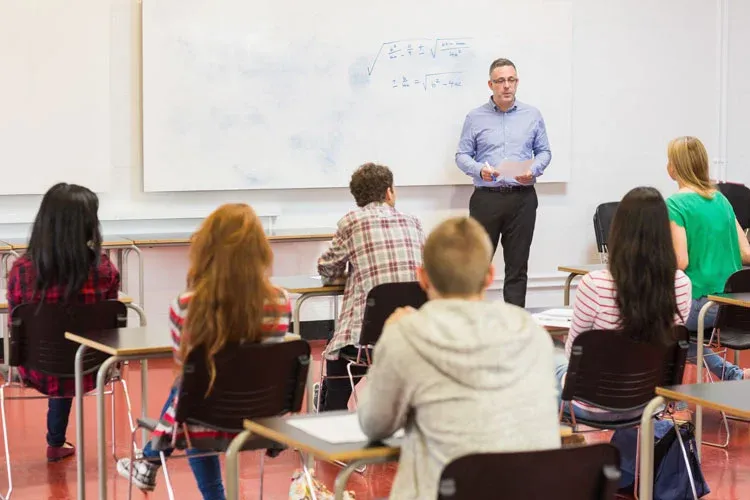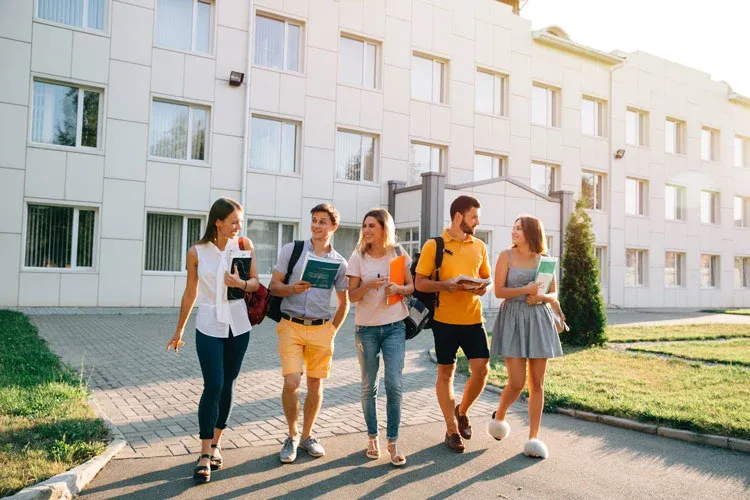When class sizes are too large, students often miss out on personalized attention, hindering their academic growth and engagement. This blog explores the ideal student-teacher ratio, how it differs from class sizes, and its significant impact on educational outcomes. We also discuss the benefits smaller student-teacher ratios offer in promoting individualized learning and ensuring students are included in the classroom.
Imagine a school where every student is known by name, their strengths and challenges are understood, and their educational journey is supported with personalized attention. This is the reality at Rose Academies. With a student body of around 150, Rose Academies maintains low student-teacher ratios and fosters an environment where students can thrive. Each student works independently within a self-paced curriculum yet always has access to teachers for guidance and support.
Continue reading to learn more about why finding the ideal teacher-student ratio is important for educational development, and contact Rose Academies today to see why we’ve become the perfect choice for parents who value quality and personalized learning in Arizona.
The Importance of Student-Teacher Ratios in Education
A low student-to-teacher ratio can enhance the quality of education by allowing for more individualized instruction. This personalized attention helps both primary school and high school students perform better academically, engage more in class, and exhibit improved behavior. Minority, low-income, and special needs students benefit from this, getting the tailored support they need to thrive.
Additionally, smaller student-teacher ratios promote educational equity by ensuring all students receive the same level of attention and resources. This fosters inclusivity and helps bridge achievement gaps between different student groups. Ultimately, lower ratios create a more balanced and fair education system than a higher student-teacher ratio.
What is the Student-Teacher Ratio?
The student-faculty ratio measures the number of students assigned to each teacher in a school. It’s an essential metric for understanding the level of individual attention a student might receive. This ratio can impact educational quality, influencing everything from classroom dynamics to student performance.
How it Differs from Class Size
While often used interchangeably, the student-teacher ratio and class size are distinct concepts. The student-teacher ratio considers a school’s total number of students and teachers, providing a broader picture of resources. In contrast, class size refers to the number of students in a single classroom, directly affecting daily teaching and learning experiences.
How to Calculate Student-Teacher Ratio
Calculating the student-teacher ratio involves dividing the total number of students by the total number of teachers. For instance, if a school has 300 students and 15 teachers, the student-teacher ratio would be 20:1. This calculation helps schools and parents gauge the potential for personalized education and overall teaching effectiveness.
The Ideal Student-Teacher Ratio
The ideal student-teacher ratio varies depending on the educational context and the needs of the students, but research generally supports smaller ratios for optimal learning outcomes. Ratios of 15:1 or lower are often considered ideal, allowing teachers to provide more personalized attention, engage effectively with each student, and address individual learning needs so all students can thrive academically and socially.
Why Student-Teacher Ratios Matter
Smaller student-teacher ratios are beneficial in early education and for students requiring additional support. In these settings, teachers can closely monitor progress, provide immediate feedback, and tailor instruction to each student’s needs. This personalized approach helps to ensure that all students, regardless of their background or abilities, receive the quality education they deserve.
Impact on Individual Attention & Support
A lower student-teacher ratio allows teachers to dedicate more time and attention to each student. This individualized support enables teachers to identify and address specific learning challenges promptly. As a result, students receive the help they need to succeed academically and develop confidence in their abilities.
Correlation with Student Performance & Outcomes
Research shows a strong correlation between smaller student-teacher ratios and improved student performance. Students in smaller classes tend to have higher test scores, better grades, and a deeper understanding of the material than those in bigger class sizes at public schools. This enhanced academic performance is due to the increased opportunities for personalized instruction and active class participation.
Relevance to Educational Equity & Inclusivity
Smaller student-teacher ratios contribute to educational equity by ensuring all students receive equal attention and resources. This can benefit minority, low-income, and special needs students who may require additional support. By reducing the ratio, schools can create a more inclusive environment where every student has the opportunity to succeed.
Average Student-Teacher Ratios in the United States
The average student-teacher ratio in the United States varies by state and educational level, typically ranging from 15:1 to 26:1 in high schools. For example, states like Vermont and New Hampshire boast some of the lowest ratios, around 12:1, while California and Nevada have higher averages, closer to 24:1. These figures highlight disparities in educational resources and the potential impact on student learning experiences across the country.
The Rose Academies’s Student-Teacher Ratios
At Rose Academies, maintaining an optimal student-teacher ratio is a priority, with an average ratio significantly lower than the national average. With a student body totaling around 150, Rose Academies ensures that each student receives the personalized attention needed to succeed.
This commitment to low student-teacher ratios allows for individualized instruction and strong student-teacher relationships, setting Rose Academies apart in providing high-quality education.
Benefits of Smaller Student-Teacher Ratios
Smaller student-teacher ratios offer numerous advantages, significantly enhancing the educational experience. These benefits include improved academic performance, increased classroom engagement, better behavior management, and greater support for minority, low-income, and special-needs students.
Improved Test Scores & Academic Performance
Smaller student-teacher ratios are linked to higher academic achievement. According to research from Education Advanced, students in classes with ratios of 15:1 or lower often score 20% higher on standardized tests than in larger classes. The National Center for Education Statistics also reports that these students show a 10-15% increase in overall GPA due to more personalized instruction and feedback.
Enhanced Engagement & Participation in Class
In classrooms with fewer students, teachers can create a more interactive and engaging learning environment. A study by the National Education Association found that students in smaller classes were 25% more likely to participate in discussions and ask questions. Increased engagement can result in a 15% improvement in comprehension and retention of the educational material.
Better Behavior & Classroom Management
Lower student-teacher ratios contribute to better classroom behavior and management. Teachers can devote more time to addressing individual behavioral issues and maintaining a positive classroom atmosphere. This results in a 30% reduction in disciplinary actions, according to the American Educational Research Association, creating a more conducive learning environment for all students.
Gains for Minority, Low-Income, & Special Needs Students
Smaller student-teacher ratios are beneficial for minority, low-income, and special needs students. These students often require more individualized attention and support to succeed. Studies have shown that lower ratios can lead to a 20% increase in academic performance and a 25% reduction in dropout rates for these groups, helping to close achievement gaps and promote educational equity.
Parental Involvement & Home Education Support
Parental involvement supports student success, especially in schools with smaller student-teacher ratios. When parents actively engage in their child’s education, it enhances classroom learning and reinforces the personalized attention students receive. Schools like Rose Academies encourage strong partnerships with parents, offering resources and support to ensure students thrive both at school and at home.
Tucson Charter Schools & Smaller Student-Teacher Ratios
Tucson charter schools, including Rose Academies, often maintain smaller student-teacher ratios compared to traditional public schools. This approach ensures that students receive more personalized attention and tailored educational experiences, fostering a supportive learning environment. At Rose Academies, maintaining low student-teacher ratios is a priority to provide individualized support and enhance student success.
Comparing Student-Teacher Ratios in Charter Vs. Public Schools
Charter schools generally have lower student-teacher ratios than public schools, which can significantly impact the quality of education. For example, Rose Academies maintains an average ratio of around 15:1, while public schools can have ratios exceeding 25:1.
This difference between charter schools and traditional public schools allows charter schools to offer more focused attention, resulting in better academic outcomes and a more engaging classroom experience.
Impact of Teacher Qualifications on Student Outcomes in Different Ratios
Teacher qualifications directly affect student outcomes, especially when considering different student-teacher ratios. Highly qualified teachers can effectively manage larger classes, ensuring quality education despite higher ratios. In smaller classes, their expertise allows for more personalized instruction, which enhances student engagement and academic success.
Student-Teacher Ratio FAQs
What is the ideal student-teacher ratio?
The ideal student-teacher ratio varies by educational context but is often considered to be around 15:1. This ratio allows for sufficient individual attention and support, fostering a productive learning environment. Research supports that ratios below 20:1 tend to produce the best educational outcomes.
Does reducing class size improve achievement?
Yes, reducing average class size generally improves student achievement. Smaller classes allow for more personalized instruction, increased student engagement, and better classroom management. Studies have shown that students in smaller classes often perform better academically and have higher levels of participation.






